In eco-conscious cities, public transport options are designed to minimize environmental impact while enhancing urban mobility. By integrating sustainable choices such as electric buses and bicycle-sharing programs, these cities promote accessibility for all individuals, including those with disabilities. Additionally, affordability plays a crucial role in encouraging the use of public transport, making it essential for users to understand fare structures and available discounts.

What Are the Best Public Transport Options in Eco-Conscious Cities?
Eco-conscious cities prioritize sustainable public transport options that reduce carbon footprints and enhance urban mobility. Key choices include bicycle-sharing programs, electric buses, light rail systems, carpooling services, and improved walking infrastructure.
Bicycle-sharing Programs
Bicycle-sharing programs offer a convenient and eco-friendly way to navigate urban areas. Users can rent bikes from various docking stations for short trips, promoting cycling as a viable transport option.
These programs typically charge a nominal fee for usage, often with subscription options for regular users. Cities like Amsterdam and Copenhagen have successfully integrated these systems, making cycling a staple of daily commuting.
Electric Buses
Electric buses are a clean alternative to traditional diesel buses, significantly reducing greenhouse gas emissions. Many eco-conscious cities have begun to replace their fleets with electric models, which operate quietly and efficiently.
These buses often have lower operating costs due to reduced fuel expenses and maintenance needs. Cities such as Los Angeles and Shenzhen have made substantial investments in electric bus infrastructure, demonstrating their commitment to sustainability.
Light Rail Systems
Light rail systems provide an efficient means of mass transit, connecting various parts of a city while minimizing environmental impact. They are typically powered by electricity, making them a cleaner option compared to conventional rail systems.
Many cities, including Portland and San Francisco, have developed extensive light rail networks that facilitate easy access to urban centers. These systems can reduce traffic congestion and promote public transport use.
Carpooling Services
Carpooling services encourage shared rides, reducing the number of vehicles on the road and lowering emissions. Apps and platforms facilitate these arrangements, making it easier for commuters to find others traveling in the same direction.
In cities like San Francisco, incentives such as reduced tolls and dedicated carpool lanes enhance the appeal of carpooling. This option not only saves money but also fosters community connections among residents.
Walking Infrastructure
Enhancing walking infrastructure is crucial for eco-conscious cities, promoting pedestrian-friendly environments. Well-designed sidewalks, crosswalks, and pedestrian zones encourage walking as a primary mode of transport.
Investments in walking infrastructure can lead to healthier lifestyles and reduced reliance on vehicles. Cities like Barcelona and Melbourne have implemented extensive pedestrian pathways, making walking a safe and enjoyable experience.

How Do Accessibility Features Enhance Public Transport?
Accessibility features significantly improve public transport by ensuring that all individuals, including those with disabilities, can use these services comfortably and safely. These enhancements not only promote inclusivity but also encourage more people to utilize public transport, contributing to eco-conscious urban living.
Wheelchair Ramps
Wheelchair ramps are essential for providing access to buses, trains, and stations for individuals with mobility impairments. These ramps should meet local regulations, typically featuring a slope ratio of 1:12 to ensure safety and ease of use. Regular maintenance is crucial to prevent wear and ensure they are functional at all times.
In cities like Amsterdam, public transport vehicles are increasingly equipped with automatic ramps, which can be deployed with the push of a button, enhancing convenience for users. When planning routes, consider the availability of accessible stops to ensure a smooth journey.
Audio-Visual Announcements
Audio-visual announcements are vital for informing passengers about stops, delays, and other important information. These systems cater to individuals with hearing and visual impairments, ensuring that everyone receives the same information simultaneously. Clear, concise messaging is key to effective communication.
Many cities have adopted digital screens alongside audio systems to display real-time updates. For example, in London, the use of both methods has significantly improved the experience for all passengers, particularly those with disabilities. Regular testing and updates of these systems are important to maintain their effectiveness.
Priority Seating
Priority seating is designated for individuals who need it most, such as seniors and those with disabilities. These seats are typically located near the entrance of vehicles for easy access. Clear signage helps remind other passengers to give up these seats when necessary.
In many public transport systems, such as those in New York City, priority seating is enforced through both visual cues and announcements. It is essential for transport operators to educate passengers about the importance of respecting these spaces to foster a more inclusive environment. Regular surveys can help assess the effectiveness of priority seating policies and identify areas for improvement.

What Are the Affordability Factors for Public Transport?
Affordability in public transport is influenced by various factors, including fare structures, discounts, and additional services. Understanding these elements can help users make cost-effective choices when utilizing public transit systems.
Subsidized Fares
Subsidized fares are reduced ticket prices funded by government initiatives or local authorities to make public transport more accessible. These subsidies often target specific groups, such as students, seniors, or low-income individuals, allowing them to travel at significantly lower costs.
For example, many cities offer discounted rates for students that can range from 30% to 50% off standard fares. It’s essential to check eligibility requirements and application processes to take advantage of these subsidies.
Monthly Pass Discounts
Monthly pass discounts provide a cost-effective option for regular commuters, allowing unlimited travel within a specified period. Typically, these passes can save users a substantial amount compared to purchasing single tickets for each journey.
In many urban areas, a monthly pass can cost around 20-30% less than buying individual tickets for the same number of trips. Users should evaluate their travel frequency to determine if a monthly pass is a worthwhile investment.
Free Transfers
Free transfers enable passengers to switch between different modes of transport without incurring additional charges. This feature is particularly beneficial for those who need to combine bus and train services to reach their destination.
Many transit systems allow free transfers within a set time frame, typically ranging from 60 to 120 minutes. Passengers should be aware of the time limits and routes covered to maximize their savings while traveling.

Which Cities Lead in Eco-Conscious Public Transport?
Several cities are recognized for their commitment to eco-conscious public transport, prioritizing sustainability, accessibility, and affordability. Copenhagen, Amsterdam, and San Francisco stand out for their innovative approaches and effective systems that reduce carbon footprints while enhancing urban mobility.
Copenhagen
Copenhagen is a pioneer in eco-conscious public transport, with a robust network of bicycles, buses, and trains. The city aims to become carbon neutral by 2025, promoting cycling as a primary mode of transport, supported by extensive bike lanes and rental services.
The integration of electric buses and the expansion of the metro system further enhance Copenhagen’s public transport efficiency. Residents benefit from affordable monthly passes, making it economical to choose public transport over personal vehicles.
Amsterdam
Amsterdam is renowned for its bicycle-friendly infrastructure, with over 400 kilometers of bike paths. The city encourages cycling as a sustainable alternative, complemented by an efficient tram and bus network that connects various neighborhoods.
Public transport in Amsterdam is accessible and affordable, with options like the OV-chipkaart, a contactless card that simplifies travel across trains, trams, and buses. This system promotes eco-conscious commuting while ensuring that residents can easily navigate the city.
San Francisco
San Francisco has made significant strides in eco-conscious public transport through its Muni and BART systems, which offer extensive coverage across the city and surrounding areas. The city is investing in electric buses and light rail to reduce emissions and improve air quality.
Affordability is a key focus, with various fare options available, including discounted passes for low-income residents. San Francisco’s commitment to sustainability is evident in its ongoing efforts to enhance public transport accessibility and reduce reliance on cars.

What Criteria Should You Consider When Choosing Public Transport?
When selecting public transport, consider factors such as environmental impact, accessibility, and affordability. These criteria will help you make informed decisions that align with your values and needs.
Environmental Impact
The environmental impact of public transport varies significantly depending on the mode of transportation. Options like electric buses and trains generally produce fewer emissions compared to traditional diesel vehicles, contributing to cleaner air and reduced greenhouse gases.
Evaluate the energy sources used by public transport systems. For instance, cities utilizing renewable energy for their transit fleets can further minimize their carbon footprint. Look for systems that prioritize sustainability, such as those implementing eco-friendly technologies or practices.
Consider the overall efficiency of the transport network. High-capacity modes, like subways and trams, can reduce the number of individual cars on the road, leading to lower congestion and pollution levels. Research local initiatives that promote greener transport options to make a more eco-conscious choice.
